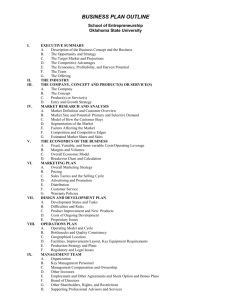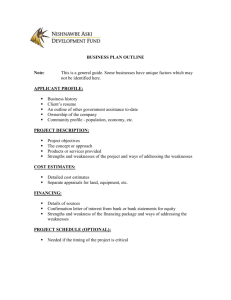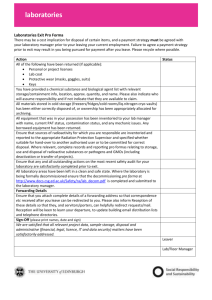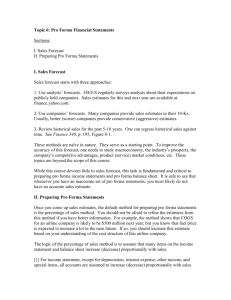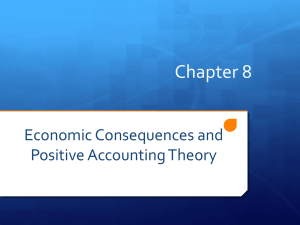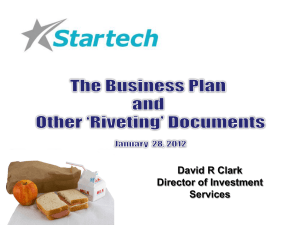NASDAQ 100 Companies Report Combined Losses
advertisement
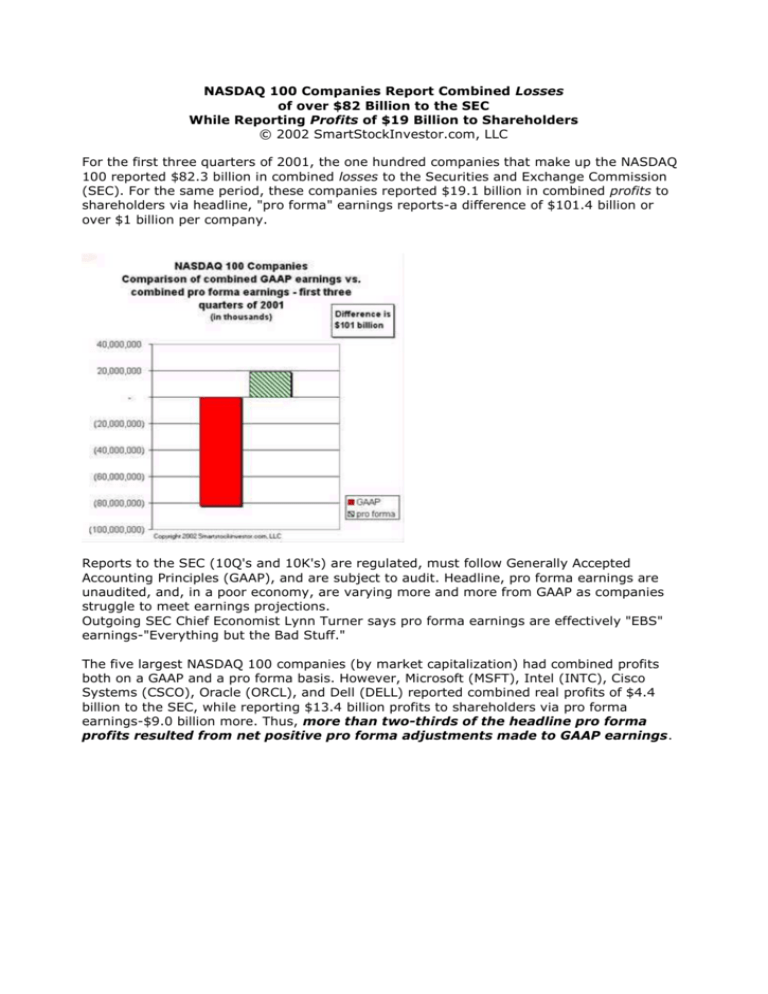
NASDAQ 100 Companies Report Combined Losses of over $82 Billion to the SEC While Reporting Profits of $19 Billion to Shareholders © 2002 SmartStockInvestor.com, LLC For the first three quarters of 2001, the one hundred companies that make up the NASDAQ 100 reported $82.3 billion in combined losses to the Securities and Exchange Commission (SEC). For the same period, these companies reported $19.1 billion in combined profits to shareholders via headline, "pro forma" earnings reports-a difference of $101.4 billion or over $1 billion per company. Reports to the SEC (10Q's and 10K's) are regulated, must follow Generally Accepted Accounting Principles (GAAP), and are subject to audit. Headline, pro forma earnings are unaudited, and, in a poor economy, are varying more and more from GAAP as companies struggle to meet earnings projections. Outgoing SEC Chief Economist Lynn Turner says pro forma earnings are effectively "EBS" earnings-"Everything but the Bad Stuff." The five largest NASDAQ 100 companies (by market capitalization) had combined profits both on a GAAP and a pro forma basis. However, Microsoft (MSFT), Intel (INTC), Cisco Systems (CSCO), Oracle (ORCL), and Dell (DELL) reported combined real profits of $4.4 billion to the SEC, while reporting $13.4 billion profits to shareholders via pro forma earnings-$9.0 billion more. Thus, more than two-thirds of the headline pro forma profits resulted from net positive pro forma adjustments made to GAAP earnings. Companies losing money were not the only ones to make extensive use of pro forma adjustments. For example, Microsoft reported earnings to the SEC of $3.8 billion for the first three quarters of 2001, but headline, pro forma earnings reported to shareholders were $7.0 billion-right in line with estimates. Intel's reported pro forma profits ($2.6 billion) were over three times its profits reported to the SEC ($0.8 billion). Recently announced fourth quarter results continue this tradition. The headline EPS number was $0.15 per share thereby allowing Intel to "beat the street" estimate of $0.11 per share. It appears the GAAP EPS they will report to the SEC in a few weeks will be $0.07 per share. If Intel's report is a harbinger of things to come in the fourth quarter, pro forma earnings for the NASDAQ 100 will once again greatly exceed GAAP earnings. Cisco Systems reported losses to the SEC of $3.0 billion, but reported pro forma profits to shareholders of $0.7 billion which "beat the street" (exceeded First Call earnings estimates). The "items," i.e., true accounting expenses, that Cisco expunged each and every quarter, were exactly enough to allow its headline pro forma earnings to be inline with or slightly better than earnings projections. These quarterly positive adjustments varied considerably and ranged from about 40 cents a share to 2 cents a share, but each quarter, Cisco's pro forma EPS ended up within a penny or two of estimates (equal or over but never under). Is this really just a fortunate coincidence? Can anyone look at the chart below and not wonder about the purpose of Cisco's pro forma adjustments? Headline, pro forma earnings are used to calculate the earnings per share amounts (EPS) and price earnings ratios (PE) reported by popular services such as Thompson Financial / First Call and Yahoo Finance. It's interesting to note that Oracle's reported headline numbers are essentially in line with GAAP. It's even more interesting to note that on January 5, Oracle (the only one of the five largest NASDAQ 100 companies that reported real earnings to shareholders instead of pro forma) had a stock that was selling for a mere 33 times real earnings (GAAP) compared with 230 times real earnings for Intel (not a typo-two hundred and thirty) and 74 times real earnings for Microsoft and Dell, all of whom enhanced real earnings substantially via pro forma adjustments. (see footnote 1) Since Cisco had no real earnings, this calculation is meaningless for them. The differences between Oracle's PE on real earnings vs. those of its four pro forma reporting peers bear witness to an unfortunate fact: pro forma reporting seems to pay off handsomely in the stock price. On a GAAP basis, 53% of the NASDAQ 100 reported profits for the three quarters. On a pro forma basis, 74% became profitable. 75% of the NASDAQ 100 reported better profits on a pro forma basis than on a GAAP basis. The average favorable difference per company for these 75 companies was $1.6 billion. The companies that used pro forma adjustments to improve earnings had a combined $87.7 billion in GAAP losses before pro forma adjustments turned them into profits. The 25 companies that did not make favorable pro forma adjustments had a combined GAAP profit of $5.5 billion. A full year 2001 PE ratio for the NASDAQ 100 based on real earnings is meaningless as earnings for the first three quarters are a negative $82 billion and full year results are certain to be negative. However, a PE can be calculated on the pro forma numbers. We took the three quarters "actual" pro forma results ($19.1 billion profit) and added in fourth quarter estimates from First Call to come up with projected full year 2001 pro forma earnings of $25.2 billion for the NASDAQ 100. Based on the one hundred companies' combined market capitalization on January 5, 2002, this yielded a pro forma PE ratio of 75 time earnings. On that date, the companies that had lost a combined $82 billion (on a GAAP basis) had a total market capitalization of $1.9 trillion. Even based on questionable pro forma earnings, the NASDAQ 100's PE ratio is lofty. Just a few years ago, "items" were large, one time only expenses and there was some justification for excluding them from results used for comparison purposes, although they should always be reported. Now, as Intel, Cisco, and so many others demonstrate, "items" seem to have become the expenses companies must exclude in order to make earnings projections. Companies are now plagued with quarterly reoccurrences of "nonrecurring" items, which are plucked from expense numbers each quarter. It strains credulity to imagine that companies like Intel and Cisco just happen to have the right amount of pro forma adjustments each and every quarter, and in widely varying amounts, to allow pro forma earnings to come in right in line or slightly ahead of earnings projections. Since the make-up of "items" varies from quarter to quarter, using pro forma earnings for comparison purposes is an exercise in futility. In the short run, pro forma earnings have helped buoy stock prices. If most NASDAQ companies followed Oracle's example and reported real earnings to the shareholders, causing their real PE's to drop to Oracle's level, how much of that $1.9 trillion is likely to vanish? Of course, in the long run, these types of deceptions have always ended badly-very badly. Sooner or later the SEC will be forced to fulfill its mission of preserving the integrity of financial reporting in this country and investors will be amazed at how much they've been duped in recent years. I asked several people including experienced investors and brokers at a large brokerage house to estimate what they thought the NASDAQ 100 companies combined earned on a GAAP basis in the first three quarters of 2001. Not one person's estimate was close and no one thought it was a loss. I asked the same question about Cisco Systems. Most had no idea, although a couple of Cisco shareholders quoted pro forma numbers. No one had any idea that Cisco actually lost a substantial amount of money in 2001 while reporting pro forma "profits" to shareholders. Cisco is being used here only as an example of a widespread and growing problem. Once the SEC does decide to do its job, it will have its hands full. The above data show that pro forma reporting is becoming the rule rather than the exception (at least for the top 100 NASDAQ companies), and, given the large numbers of companies that practice this now mostly deceptive reporting, policing abuses may involve a massive effort. These findings are a sad commentary on the state of financial reporting in the United States. John J. May, MBA SmartStockInvestor.com January 21, 2002 http://www.smartstockinvestor.com/commentary.html
